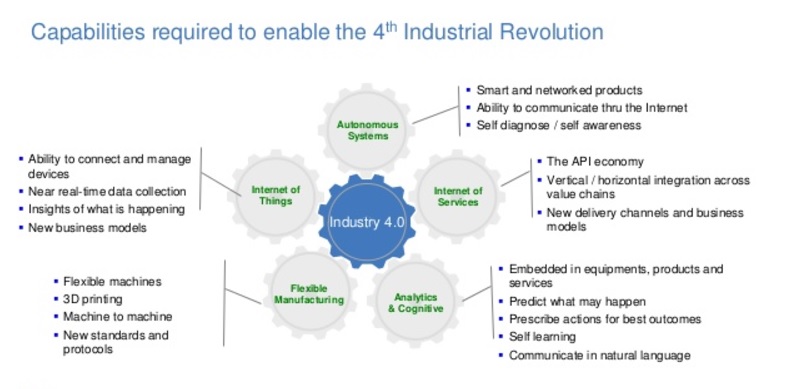Internet of Things (IOT)
Cognitive manufacturing: the close-to-my-bed-show
14/07/2017 | Written by: Ronald Teijken
Categorized: Internet of Things (IOT) | Watson
Share this post:
On June 15, 2017 I gave a presentation on Industry 4.0 and IBM Watson IoT at the IoT Convention in Mechelen.
What struck me that day was how pervasive the theme of Industry 4.0 has become in the interim. Many questions are being asked, not so much about what the theme involves, but rather the practical steps for getting started. A shift has occurred in the market in a relatively short time. We have entered the practical applications stage. Learn how progressive manufacturers have embraced IoT technologies. Download this report from Greg Cline Research Analyst Manufacturing and Product Innovation & Engineering (PIE).
In my presentation, I emphasized the fact that Industry 4.0 extends much further than just IoT. Connectivity is the basis. Implementing sensors on a large scale makes it possible to remotely monitor and control devices and processes. However, this much broader IoT connectivity does not constitute a fourth industrial revolution. More is involved. We speak of a new industrial revolution, because other disruptive technologies are emerging at the same time. The mutual relationships among these technologies are what we refer to as Industry 4.0.
These parallel technologies are: Autonomous Systems (self-diagnosis, self- awareness), the Internet of Services (also known as the API economy), Analytics & Cognitive and Flexible Manufacturing, with 3-D printing as the eye-catching standard bearer of this trend.
New business models are being developed using the data stream that is created by all these connected devices, locations and processes – for example models involving predictive maintenance.

During my presentation, I offered three examples of Industry 4.0 applications that spark the imagination.
RAMLAB printing
RAMLAB is a Rotterdam start-up that provides on-demand 3-D metal printing of parts and spare parts for industrial applications. RAMLAB has linked its laser robots to an analytics platform based on IBM Watson. This ensures that the machine’s actions are continually analyzed. Immediate response is thus possible in the event of any aberrant behavior. What is new is that the process output is now being tracked, as well. This is real-time quality control during production.
Exactly how important this is for RAMLAB can be demonstrated by the fact that it takes about 200 hours to print a screw propeller. Not a production activity that you would care to repeat if quality deviations are discovered (later). Applying Industry 4.0 technology ensures that RAMLAB can provide its customers unprecedentedly high quality and availability guarantees.
So proud! Recently RAMLAB is nominated by the Computable in the category ICT-project of the year of Small-Medium Enterprises category (‘ICT-project van het jaar in het MKB’) This is the feedback of the jury: “A great example of originality and innovation, where complex issues such as cognitive computing and machine learning jointly operate on the frontline of current technology. Cooperation with various organizations worldwide, as well as the complexity of the entire manufacturing process, make this a smart industry project within the fourth industrial revolution.” Vote here for this cool project!
Olli
Olli is a self-driving minibus, developed by the start-up Local Motors, in collaboration with an IBM team. The extraordinary thing about Olli is that, in addition to being able to drive autonomously, it is also self-learning. Thanks to its connection to IBM Watson, Olli analyses the best route and learns from its experiences. Moreover, Olli is equipped with natural speech processing technology, so it can converse with you, as well.
Kone elevators
Kone began installing sensors on its elevators a year and a half ago. This makes it possible to remotely monitor them and improve service. The next step was to realize cloud access to the elevators’ controls. This made a remote reset possible.
In the interim, a third step has been taken and the data stream that this system continually delivers is being analyzed using IBM Watson. If equipment indicates aberrant behavior, Kone sends an Engineer to the customer site.
Kone has altered its positioning in the market based on the integration of these new technologies. The company is no longer presenting itself as a supplier of elevator installations, but as the supplier of guaranteed passenger movement, or connected services.
“Clearly the era of cognitive manufacturing has begon.”
Everyone must determine his own position in this fascinating force field. IoT fundamentally changes how production organizations create value. Learn how progressive manufacturers have embraced IoT technologies. Download this report from Greg Cline Research Analyst Manufacturing and Product Innovation & Engineering (PIE).

Business Partner Manager Netherlands @ IBM for Asset management, Internet of Things, Supply Chain and AI.
Struggling with Artificial Intelligence?
Wondering how Artificial Intelligence (AI) really works? Do you feel like it is just a black box which, when asked, magically comes up with an answer? Do you trust the so called “black box”? Recently this article appeared in the dutch newspaper The Telegraaf about Ethics and AI. It touched the discussion on how […]
Ultra short time to market with AI? It is possible!
Time to market is a distinctive success factor in the digital age. This certainly applies to the development of new or improved products and services, and creating an optimal relationship with the customer. An intelligent handling of data can help. This does not have to take weeks or months anymore. The role of data scientists […]
Hack Belgium: my contribution to tech, talent and social benefit
The value of hackathons is not to be underestimated. The vibe is on the one hand comparable to my daily work as Senior Consultant and Project Manager at IBM, and at the same time so different. The atmosphere is relaxed and informal, but everything happens at a high pace with a strong focus on the […]






























